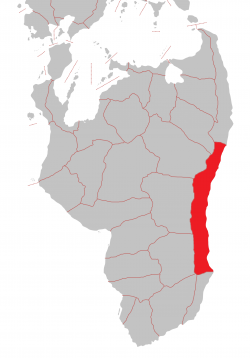Kai Fa (Pacifica)
The Socialist Republic of Kai Fa | |
|---|---|
|
Flag | |
Motto: Unity, Equality, Independence | |
Anthem: The Victorious March | |
 Location of Kai Fa in Pacifica | |
| Location | West Bareland. |
| Capital and largest city | Tom Yam |
| Official languages | Sinic |
| Religion | Buddhism 45.3%
No religion 28.4% Folk religion 23.4% Christianity 2.9% |
| Demonym(s) | Kai Fa |
| Government | Unitary one-party socialist republic |
• Core Leader | Lo Pol |
| Legislature | National People’s Assembly |
| Formation | |
• Landing of the Founders at Kou Fu | 676 |
• Establishment of the First Empire | 1271 |
• Establishment of the Two Kingdoms | 1527 |
• Establishment of the Second Empire | 1861 |
• Establishment of the Socialist Republic of Kai Fa | 1949 |
| Area | |
• Total | 134,650 km2 (51,990 sq mi) |
| Population | |
• 2022 census | 39,506,923 |
• Density | 293.04/km2 (759.0/sq mi) |
| GDP (nominal) | estimate |
• Total | $225 billion |
• Per capita | $5,700 |
| Currency | Kiringul |
Kai Fa, officially the Socialist Republic of Kai Fa, is a unitary state in West Bareland.
Located between the mountains and the sea in West Bareland, with a climate ranging from subtropical to temperate, Kai Fa is a developing country with a lower-middle-income, but speedily growing, economy. With rich coal and iron deposits, its main industry include mining, steelmaking, petrochemicals, vehicles and machinery, electronics, fabrics and fishing.
Officially a single-party socialist state, in the last decade under the leadership of Core Leader Lo Pol it has acquired increasing dictatorial traits.
History
Five States era (676 – 1271)
The first, Sinic-speaking inhabitants of Kai Fa arrived by sea in 676. Through time, five cities emerged among the others, forming the Five States of Tom Yam, Chau Fan, Ba Bao, Kong Bao and Tou Fu. In 918 catastrophic floods swept across Kai Fa, destroying the fields and causing widespread famine. They signalled the beginning of an era of social and economic instability, marred by wars, revolts and disasters. In 1216, the Tom Yam State had regained stability and prosperity and expanded southward either by war or marriage, until in 1271 its leader Lo Char was crowned Emperor of Kai Fa in Tom Yam.
The First Empire (1271 – 1527)
The Empire flourished and the court in Tom Yam became a renowned centre of arts, literature, philosophy and sciences. From 1378, a succession of weak Emperors followed, while powerful Ministries became the true rulers of the country. Famines and plagues, combined with high taxation, made resentment mount especially in the South. The Won dynasty of Tou Fu rebelled in 1515, followed by most southern clans. In 1527, near the village of Dong Po, Emperor Lo Son was killed in battle and its army routed. The two sides created a new border on the river Er Kwai.
The Two Kingdoms (1527 - 1861)
The Northern Kingdom chose a conservative path: ruled by a landlord nobility and weak kings, it remained a centre for arts and traditional culture but lagged behind on economy and science. The Southern Kingdom, ruled by warlike noble clans, developed vibrant crafts and merchant classes and became a regional sea power. In 1661, the Won dynasty ended and was succeeded by the Chop. In 1848, the ambitious king Chop Suey, set the country on a path of accelerated modernization. In 1860, Suey opened hostilities against the Northern Kingdom. In spring 1861 the New Army marched toward Tom Yam and the last king Chow Lan committed suicide in its palace hours before Chop Suey made its entranced and proclaimed the restoration of the Empire.
The Second Empire (1861 - 1949)
Suey and its successors pushed on the path of forced modernization, achieving a partial success in the city but facing much more difficulties in the countryside. In 1911 a massive protest against the unpopular Emperor Chop Mian forced him to allow political parties and concede elections. Two decades of turmoil followed, during which, in 1924, the Communist party was founded by Chairman Gau Bun. In 1937, Generalissimo Ma Po took power, despite the nominal imperial title still retained by the adolescent Chop Siu, and civil war broke out. In 1949 Ma Po flew abroad with its last supporters, while Chop Siu was arrested and Chairman Gau Bun became the first Core Leader of the new Socialist Republic of Kai Fa.
The Socialist Republic of Kai Fa (1949 - today)
The new Communist regime banned other parties, installed a new public structure and turned to a socialist planned economy. In 1966 Brother Gau Bun died and Party’s factions engaged in a decade long struggle for power. From 1978, Core Leader Jiao Zi launched a broad program of reforms, which opened Kai Fa economically and diplomatically to the outside world and helped the modernization and recovery of its economy and society. Starting from 1991, Kai Fa surged as a major producer in several new industries such as textiles and electronics. In 2011 Chairman Lo Pol became the new Core Leader of the Republic and began consolidating its personal power, assuming increasingly dictatorial traits. In 2018, Kai Fa signed an alliance treaty with Bruuma, along which the country supported the communist rebels of the WPR during the Reizen Civil War.
